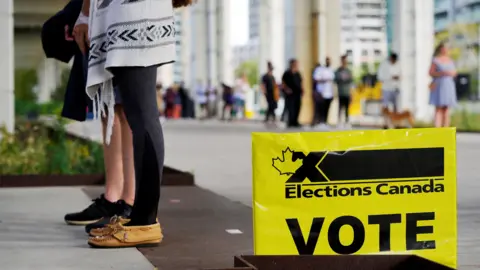BBC News, Toronto
Millions of Canadians voted on Monday in a snap federal election that has largely focused on how the candidates would respond to US President Donald Trump’s threats of tariffs as well as his call to make Canada the 51st state.
Prime Minister Mark Carney, current leader of the Liberal Party, called the vote in March shortly after taking over from former Prime Minister Justin Trudeau. His main opponent in the race was Conservative leader Pierre Poilievre.
Carney is now projected to have won a fourth mandate for the party.
Here’s what you need to know.
Has the winner been declared?
Shortly after 22:00 EDT (03:00 BST), Canada’s public broadcaster CBC News projected that Mark Carney’s Liberal Party was on its way to win enough seats in the House of Commons to form a government.
It’s not yet clear if they have secured a majority and the counting of ballots is ongoing. It’s likely we’ll know how many seats each party has won in the coming hours.
Federal election officials are required to count ballots by hand in front of witnesses. Ballots are tallied only after polls close in each location where the votes were cast.
These projections are based on initial results from Elections Canada, which runs the country’s federal elections.
Officials double-check vote totals after the election.
Is Carney already the Prime Minister?
Liberal leader Mark Carney does not need to be sworn in again. Instead, he will continue doing his job, as do his Cabinet ministers.
Should Carney decide to reshuffle his Cabinet, there will be a ceremony with the governor general, but until then, the ministers stay in their posts.
Carney may indeed choose to shuffle his Cabinet after bringing in a leaner team when he became prime minister last month.
When Parliament opens after an election, expect the swearing-in of members and the election of the Speaker.
What has Carney said he will do as PM?
One of his priorities is to navigate the relationship with US President Donald Trump.
When the pair spoke in late March, Carney and Trump agreed they would begin negotiations about a new economic and security relationship right after the election.
When Parliament returns, it’s possible we see the Liberals quickly introduce legislation focused on securing Canada’s economy in the face of US tariff headwinds.
That could include a promised tax cut for middle-class Canadians, and moving ahead with a “one project, one review” process to speed up approval for key energy and mining proposals.
The Liberals have said they want to make Canada a “clean and conventional energy” superpower.
They have also committed to putting C$5bn into a trade diversification fund.
Do the Liberals have a majority government?
The Liberals could be the largest party in the House of Commons, but may still fall short of the 172 required for a majority.
The most likely scenario if this happens is that they form a minority government with Carney as prime minister, where they strike deals with the other parties to survive no-confidence votes and pass legislation in Parliament.
The Conservatives are on track to once again form the Official Opposition.
 Reuters
ReutersWhat happens next for Conservatives?
Conservative leader Pierre Poilievre is on track to make significant inroads with the party’s vote share, securing roughly 41% of the vote with just over half of polls reporting, according to Election Canada.
That would be the highest the party has in decades.
They are currently projected to have won 148 seats – that’s up from 120 at dissolution, when the election was called.
But with the progressive vote coalescing around the Liberals, those numbers weren’t enough to win.
This will be a bitter loss for the Conservatives, who only months ago had a clear path to victory and will now need to figure out a way forward after a series of electoral defeats.
It will now be up to the party to decide if they want to keep Pierre Poilievre on as leader, the third leader they’ve had since the Liberals swept the 2015 election.

www.bbc.com
#Carneys #Liberals #won




